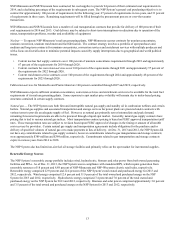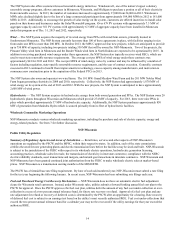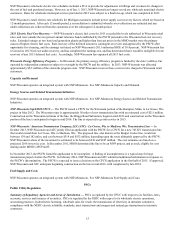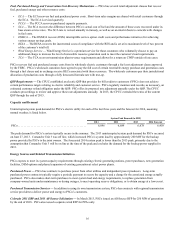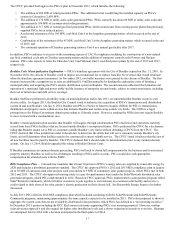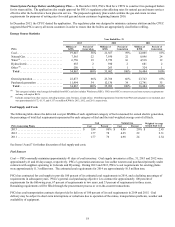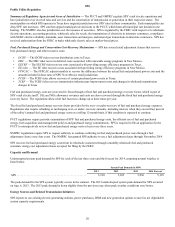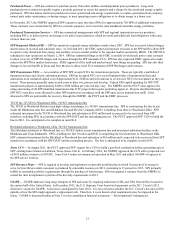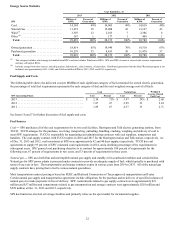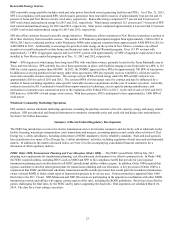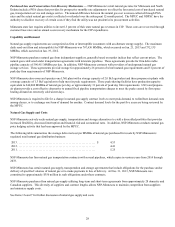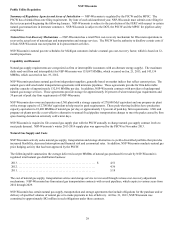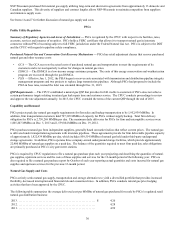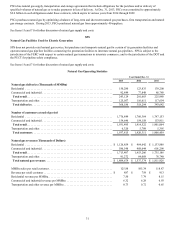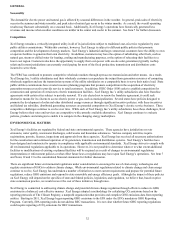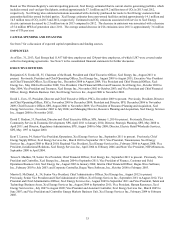Xcel Energy 2013 Annual Report Download - page 41
Download and view the complete annual report
Please find page 41 of the 2013 Xcel Energy annual report below. You can navigate through the pages in the report by either clicking on the pages listed below, or by using the keyword search tool below to find specific information within the annual report.23
Renewable Energy Sources
SPS’ renewable energy portfolio includes wind and solar power from both owned generating facilities and PPAs. As of Dec. 31, 2013,
SPS is in compliance with mandated RPS, which require generation from renewable resources of approximately four percent and 10
percent of Texas and New Mexico electric retail sales, respectively. Renewable energy comprised 12.7 percent and 8.0 percent of
SPS’ total owned and purchased energy for 2013 and 2012, respectively. Wind energy comprised 12.1 percent and 7.4 percent of SPS’
total owned and purchased energy for 2013 and 2012, respectively. Solar power comprised approximately 0.4 percent and 0.5 percent
of SPS’ total owned and purchased energy for 2013 and 2012, respectively.
SPS also offers customer-focused renewable energy initiatives. Windsource allows customers in New Mexico to purchase a portion or
all of their electricity from renewable sources. The number of Windsource participants dropped from approximately 1,000 in 2012 to
900 in 2013 due to residential attrition, while Windsource MWh sales remained consistent from approximately 4,400 MWh in 2012 to
4,400 MWh in 2013. Additionally, to encourage the growth of solar energy on the system in New Mexico, customers are offered
incentives to install solar panels on their homes and businesses under the Solar*Rewards program. Over 115 PV systems with
approximately 7.6 MW of aggregate capacity and over 80 PV systems with approximately 4.5 MW of aggregate capacity have been
installed in New Mexico under this program as of Dec. 31, 2013 and 2012, respectively.
Wind — SPS acquires its wind energy from long-term PPAs with wind farm owners, primarily located in the Texas Panhandle area of
Texas and New Mexico. SPS currently has six of these agreements in place, with facilities ranging in size from under two MW to 161
MW for a total capacity greater than 600 MW. In 2013, the NMPRC approved three PPAs for approximately 700 MW of wind power.
In addition to receiving purchased wind energy under these agreements, SPS also typically receives wind RECs, which are used to
meet state renewable resource requirements. The average cost per MWh of wind energy under the PPA and QF contracts was
approximately $26 for each of 2013 and 2012. The cost per MWh of wind energy varies by contract and may be influenced by a
number of factors including regulation, state-specific renewable resource requirements and the year of contract execution. Generally,
contracts executed in 2013 continued to benefit from improvements in technology, excess capacity among manufacturers, and
motivation to commence new construction prior to the expiration of the Federal PTCs in 2013. At the end of each of 2013 and 2012,
SPS had over 1,000 MW of wind energy on its system. With these projects, SPS is anticipated to have approximately 1,800 MW of
wind power.
Wholesale Commodity Marketing Operations
SPS conducts various wholesale marketing operations, including the purchase and sale of electric capacity, energy and energy related
products. SPS uses physical and financial instruments to minimize commodity price and credit risk and hedge sales and purchases.
See Item 7 for further discussion.
Summary of Recent Federal Regulatory Developments
The FERC has jurisdiction over rates for electric transmission service in interstate commerce and electricity sold at wholesale, hydro
facility licensing, natural gas transportation, asset transactions and mergers, accounting practices and certain other activities of Xcel
Energy Inc.’s utility subsidiaries, including enforcement of NERC mandatory electric reliability standards. State and local agencies
have jurisdiction over many of Xcel Energy Inc.’s utility subsidiaries’ activities, including regulation of retail rates and environmental
matters. In addition to the matters discussed below, see Note 12 to the accompanying consolidated financial statements for a
discussion of other regulatory matters.
FERC Order 1000, Transmission Planning and Cost Allocation (Order 1000) — The FERC issued Order 1000 in July 2011
adopting new requirements for transmission planning, cost allocation and development to be effective prospectively. In Order 1000,
the FERC required utilities, including RTO’s such as MISO and SPP, to file compliance tariffs that provide for joint regional
transmission planning and cost allocation for all FERC-jurisdictional utilities within a region. In addition, Order 1000 required that
regions coordinate to develop interregional plans for transmission planning and cost allocation. A key provision of Order 1000 is a
requirement that FERC-jurisdictional wholesale transmission tariffs exclude provisions that would grant the incumbent transmission
owner a federal ROFR to build certain types of transmission projects in its service area. Various parties have appealed Order 1000
final rules to the D.C. Circuit. NSP-Minnesota and NSP-Wisconsin are participating in the appeals in coordination with other MISO
transmission owners and utilities who oppose certain aspects of the rules, including the ROFR prohibition. Briefs have been filed by
parties challenging the final rules, by the FERC and by parties supporting the final rules. Oral arguments are scheduled March 20,
2014. The date for a Court ruling is uncertain.


